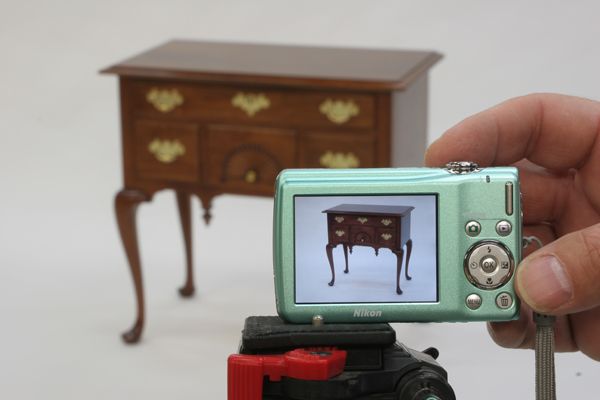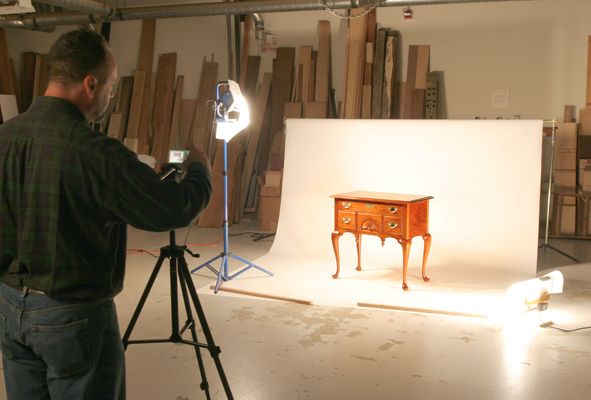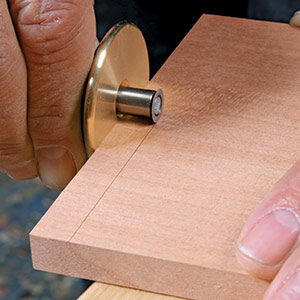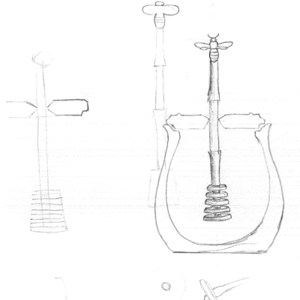
Using the digital camera you already own, you can create magazine-quality images of your woodwork.
One of the first things I learned when I came to Fine Woodworking is that anyone can be taught to take great photos. And today’s digital cameras make it even easier and cheaper to do so. I also learned the simple formula behind a clear and engaging how-to article. I’ll share both at my weekend workshop at Marc Adams School of Woodworking October 9-10, 2010. Even if you don’t plan to become a famous woodworking author, you’ll walk away with much-improved writing and photography skills.
If you can’t make it to Marc Adams’ school this fall, be sure to watch the next few issues of Fine Woodworking for a similar article by our art director, Mike Pekovich, where he will demonstrate how anyone with a digital camera, a cheap tripod, and a few inexpensive lights can take magazine-quality photos of their projects. Whether you plan to publish these photos on your own Web site or on FineWoodworking.com, or just keep a record of all the beautiful things you’ve built, Mike will shine a light on simple tips and techniques anyone can use.
I’ll be teaching Mike’s technique at my hands-on weekend workshop. Bring your digital camera to Marc Adams’, and a tripod if you have one, and we’ll work through the process together. But that’s not all we’ll cover there.
I’ll start with where and how to get published. There are at least 10 woodworking magazines out there, each with its own Web site, plus a handful of other independent Web sites, each constantly hungry for new content. So there are more ways than ever to share your favorite techniques and finished projects with the world. We’ll talk about everything from quick tips to full articles to images for online galleries, what magazines are looking for, and what they pay (or don’t pay). And I’ll tell you about the other benefits of being published, such as building up your brand name for a future teaching career.
We’ll share some good coversation and good food. You can ask me anything you want about Fine Woodworking, and I’ll try to come up with a good answer! Hope to see you there. If you’ve never visited Marc Adams’ school before you are in for a treat.

























Comments
>And I'll tell you about the other benefits of being published, such as building up your brand name for a future teaching career.< Asa, It has appeared to me that over the past few years many professional woodworkers have entered into the realm of teaching and opening their own schools, a sign of the future of the professional woodworker. Is this what’s driving the world of woodworking today? Don
Definitely, Don. In this economy (maybe short-term) and this culture (probably longterm), it is increasingly difficult to sell custom-made furniture. Alomost every pro woodworker I know is increasingly supplementing their income with teaching gigs.
But those are the pros. Not much has changed with the hobbyists, other than the fact they they are getting older, and not as many young people (say, under 50!) are discovering woodworking these days.
Asa I have written several articles in the past 4 or 5 years and had 4 published what is your magazine looking for and how do the readers submit articles to the magazine?
Thanks Kev!
Asa, regarding the aging of the woodworking population, I'm concerned about many things, not the least of which is the implied future of my favorite magazine. I'm sure I should know this, but what is the "industry" - the manufacturers and media brands engaged in pro/hobbyist woodworking - doing to help interest younger woodworkers? I'm a media consultant and a somewhat accomplished amateur woodworker, and I don't see a unified, visible effort to refill our ranks from the younger end. I'd love to know what's going on and how enthusiasts like me can help.
Asa, while I appreciate the enthusiasm aimed at producing articles for FWW, the approach seems to be lacking in recognition and respect for professional-level photographic skills and techniques. The equivalent woodworking class would be "Learn how to make Hepplewhite chairs in an afternoon". Pro photographers spend years learning how to do this well, and spend a lot of money on the proper equipment. Is FWW really looking for more poorly-lit fuzzy photos done with digi-point-n-shoot cameras for the magazine?
Hi Asa. The class looks interesting, but October is a long way off. Have you or Michael got anything published that would help me with photographing my work? I'm working on marketing now, and could use some help with photos.
Regards, Joel
>The equivalent woodworking class would be "Learn how to make Hepplewhite chairs in an afternoon".< Ralph (two comments down) brings up a very good and interesting point.
I believe that there has been an over-reaction to this simple article about taking a few shots for your projects with a digital camera. This is NOT trying to build a Hepplewhite chair in an afternoon. FWW is the best working mags with layouts/photographs. I do not believe that they have a layout designer for furniture photos as does their sister publication Fine Cooking (my other hobby and passion)has on staff. I am a serious weekend photographer. Today with a digital camera, a few lights, a large white background and photshop, most woodworkers can take the appropriate shots to accompany an article submitted for woodworking publications. They are not taking shots that will appear in Architectural Digset or a "Coffee Table Book". They will have professional photographers to do their shots. Taking a photograph for Architectural Digset is the Hepplewhite chair comparison.
Sorry for my LONG delay in responding. I lost track of this one.
On the photograph thing: Of course, we can't teach you everything in an article, or even a book, and shooting a piece of furniture indoors is just one small slice of the art and craft of shooting photos.
But it's amazing how much better your furniture shots will be with a few simple accessories and some helpful tips. Check out our article in FWW 213, out on newsstands right now. That has all the proof you'll need.
As for how to submit articles to FWW: We are a how-to magazine, so we are looking for clever techniques and tasteful projects, ones that will appeal to a broad cross-section of our readers, most of whom are intermediate woodworkers. To submit an article, go to: https://www.finewoodworking.com/pages/fw_authorguideline.asp
And as for the aging of our raedership, you are spot on with that one. Simply put, not enough new or young peoplke are coming in to the craft to replace those who are aging out of it. And you are right again that there is no unified effort to change that. We don't have the resources to do it on our own, though we promote and feature young peoples' work whenever we can, and we have created a free video series on Getting Started in Woodworking aimed at attracting and supporting new woodworkers. We also tried to get a coalition of manufacturers to pitch in money for a National Woodworking Day, but the economy tanked and money was tight. All I can say to you is be an ambassador for the craft. Invite younger folks over to your workshop to do projects. Join your local woodworking guild and help them improve their outreach programs, things like that.
Log in or create an account to post a comment.
Sign up Log in